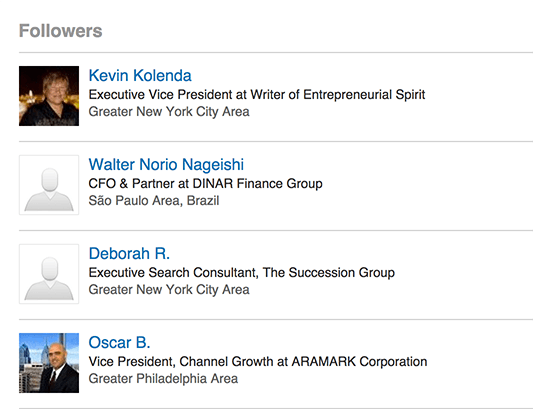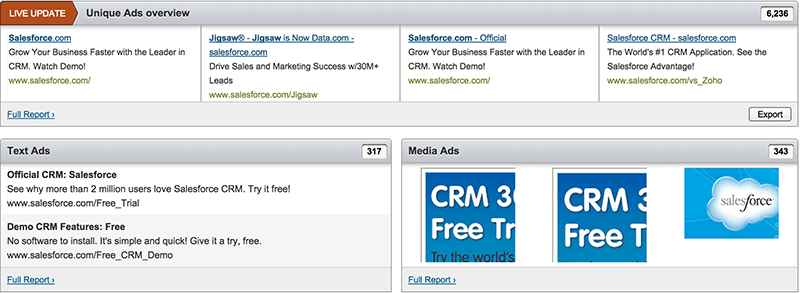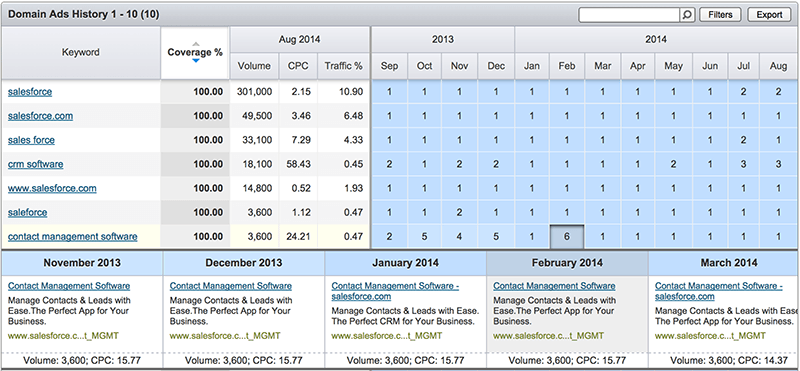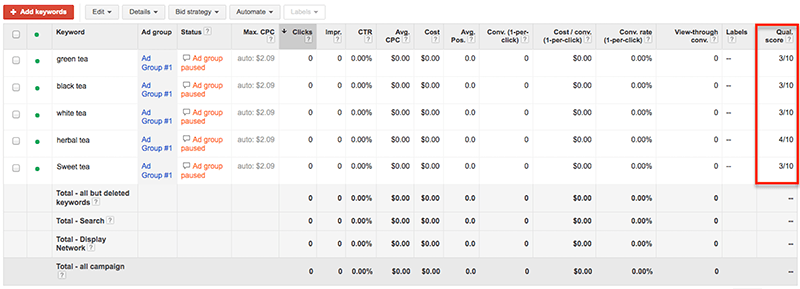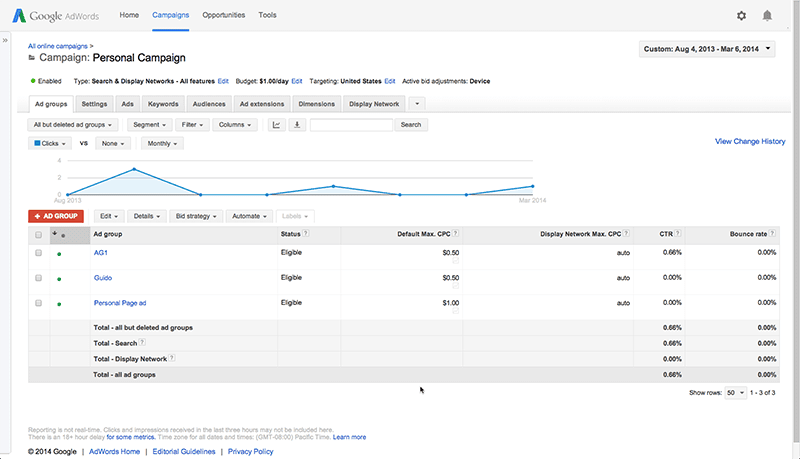You’re invested in an online marketing strategy. SEO is in play. Content strategy, email campaigns, and link building are driving traffic, leads and domain authority. One of your top performers, though, is beginning to show signs of stagnation: paid search marketing, AKA PPC (pay-per-click advertising).
Paid search ads, those ones you see every time you make a Google search — results marked “ad” that show up before, after and in-between the organic (unpaid) search results — and the retargeted ads found on other websites, rely on your paid search strategy. But what if your clicks, impressions, acquisitions and overall leads are beginning to decline? Or what if you’re taking over the PPC strategy from a previous coworker who may not have known exactly what they were doing?
We’re here to help with eight steps to optimize your PPC strategy and reinvigorate your paid search efforts — so you can drive business and get the most out of the money you’re spending for those precious clicks.
Often, these PPC ads snatch users’ clicks simply by proximity; other times its snappy ad copy that draws them in. Whatever it is, it works — PPC is known to drive traffic and revenue, especially when it’s properly optimized at every stage of setup.
*Disclosure: We only feature services and products we honestly believe in and our perspectives are genuinely our own expert perspective. This post may contain affiliate links from which we earn a small commission, at no additional cost to you.
Step 1: Re-Evaluate Campaign Bidding Strategies
When it comes to the results you get from PPC, your choice of campaign bidding strategy in paid search is key. As you know, in Google AdWords, there are three types of strategies from which to choose. You want to choose a strategy based on your desired results, outlined below and aligned to the respective bidding strategy. If you’re not getting the traffic, leads or conversions you’re hoping for, re-evaluating your campaign bidding strategy is an essential first step to revamping your paid search program.
CPM – Cost Per Mille
Cost-per-mille bidding (it’s called CPM, as in “cost per mille,” as in the Romance-language word for “thousand;” so it’s really cost-per-thousand-impression marketing) means you’re going to pay for the number of times your ad is shown to users (“impressions”). This strategy is good for companies that want to increase brand exposure, because it spreads ads throughout the Google Display Network (GDN). The GDN is a network of millions of websites that display text and media ads submitted by Google AdWords advertisers.
Note: Ads using CPM bidding are not shown in Google search results, but instead on text and banner ads throughout the aforementioned GDN. They’re grouped into paid search marketing because they use retargeting, based on a users’ search activity, to serve up relevant ads beyond the SERP (search engine results page).
Desired Result
Increased exposure for your business or brand with a secondary effect of increased traffic. Note, however, that increased website traffic isn’t a given — just because users are seeing your ad doesn’t mean they’re clicking it. A CPM strategy is ideal, though, if you’re trying to drive brand awareness, associate your brand name with a product category or capture market familiarity from competitors.
CPC – Cost Per Click
Cost-per-click bidding means you’ll pay for the number of times a user clicks on your ad. This strategy is good for brands that want to increase their website traffic and these ads will appear on the SERP, among other places online throughout the GDN.
Desired Result
Generating qualified leads. Users clicking these ads will do so because the ad meets their needs in relation to their search query. It’s still up to you to match the buyer’s intent (purchase or awareness?), but overall, you’re going to be garnering traffic from users specifically interested in what you have to offer, inserting them in the sales funnel or customer journey.
CPA – Cost Per Acquisition
Cost-per-acquisition bidding means that you will pay for the number of conversions generated by your ad. This strategy is good for brands that want to focus fully on increasing direct sales with their paid search campaign. Again, these, too, will appear on the SERP, among other places online throughout GDN.
Desired Result
Making sales. Since you’re paying by acquisition, you only get charged when the user converts. But, you’re going to get charged a lot, relative to the other bidding strategies. CPA also won’t be effective unless you’re really dialed into your keywords, customer journey and conversion points — and you better have your landing page dialed in (don’t even think about sending this user to a blog post or other non-converting page). In general, B2B companies tend to avoid CPA, but it may be a good option for B2C, especially with services such as lawyers, plumbers and the like.
Bidding Strategy Affects Your Entire Campaign
It’s important to get your bidding strategy locked in from the beginning of the optimization process, since it will shape the keywords you select and the way you optimize your ad copy and extensions.
Step 2: Audience Targeting
Who are your ideal customers? Defining a specific audience will ensure a maximum return on investment for your search marketing campaign. This may or may not have been thoughtfully considered when your PPC strategy was initially set up. Regardless, if it’s been awhile since you evaluated audience or you’re not seeing the results you want from PPC, chances are there’s a disconnect between who should be seeing your ads and who is actually seeing them.
There are two ways to define your audience. If you have an existing customer base, you can analyze their demographics:
- Where are they located?
- What is the size of their company?
- What terms do they use when referring to your company, products and services?
- Are they more likely to be on a desktop, tablet or smartphone?
If you’re in the process of building a customer base, then you’ll need to define the ideal customer for your business and put yourself in their shoes. You can even gain some insight from your competitors’ customer base by looking at the list of followers your competitors have on LinkedIn.
By clicking through a few pages, you gain insight into your ideal customer’s location, job title, company and industry. In addition to helping you with your search marketing campaign, use this knowledge to power paid advertising on LinkedIn and Facebook.
We’ve also created a handy, in-depth guide to help you define a target audience if this is unfamiliar to you or you just want to be thorough.
As you define your audience, you can also go a step further to develop personas to target your ads toward. You can use these personas in other areas of your online marketing, especially content and social media — at Digital Current, we’re a big fan of persona-based marketing strategies as a holistic approach.
Step 3: Review and Re-Strategize Your Keywords
Knowing your target audience becomes exceptionally helpful when you now look at your keyword set and again later, when we touch on ad and landing page optimization.
Keywords are the foundation of both organic and paid search engine marketing, making a keyword review an important step in the optimization of a paid search marketing campaign. The keywords you use in your paid search marketing campaign must be focused on attracting clicks from potential leads and customers for your business, therefore only those with commercial intent will be applicable to your campaign. In other words, you want users querying these keywords to be as close to the purchasing phase of their buying journey as possible — and you won’t want to only go for the major players, but instead find lucrative niche keywords with less competition.
How can you determine the intent of a keyword? Start by doing a Google search for it. If you notice the top 10 search results are informational (Wikipedia entries, blog posts, etc.), then it’s likely non-commercial, or more applicable to a buyer’s research phase than their purchasing phase. (However, if you’re looking to garner impressions with a CPM strategy, the research or awareness phase may, in some cases, be a good area of focus.)
If you notice the top 10 search results include competitors and lots of AdWords ads at the top and right side of the page, it’s likely commercial — users are ready to buy and trying to find the best option for them. This is where you’ll want to compete by placing your own ads.
When optimizing a PPC campaign, be sure to analyze your current keywords first, to see if any of them are still working or still have opportunity to perform. Then, try to find a new set to work with or to add to those original keywords.
In step four, we’ll also talk about using competitor research to guide keyword evaluation (among other things).
Step 4: Perform a Competitive Analysis
If you’re not aware of your competitors’ strategies in your PPC market, at least in a general sense, you’re probably going to flounder when it comes to your own PPC strategy. They’re either going to blow you out of the water when it comes to capturing clicks or you’re going to make mistakes they’ve already figured out — and then be scrambling to catch up.
There are lots of ways to use your competitors as a part of your overall online marketing strategy, and specifically for your paid search marketing. PPC tools can help you analyze your competitors’ search marketing strategy. SEMrush, for instance, will show you competitors’ ad keywords and current search ads, including text ads and media (image/video) ads.
You can even browse their ad history, which will give you insight into which ads perform best for them based on the length of time your competitor ran specific ads. In addition, you’ll get to see when competitors run ads, which is highly useful for seasonally based businesses.
SEMrush will also give you additional paid search competitors to research based on the initial competitor you entered or keywords you specified. The more competitors you analyze, the more insight you have into paid search for customer acquisition in your industry.
Step 5: Optimize Your Ad Copy
After that competitive analysis is complete, you should have a good idea of the ways you can optimize your ad copy to receive the most targeted clicks for your business. Because paid search ad copy is brief (25 characters for the headline and 70 characters for the description), the text you use must draw a searcher’s attention and convince him or her to click.
If you notice a competitor is using specific ad copy for a long period, there’s a good chance that the ad converts well and, therefore, it’s a good ad copy formula to emulate. Don’t copy their work, of course — that’s never good practice! But look at the tone and perspective they’re using (Is it positive or negative? Is it driving a proactive approach or appealing to a reactive purchase phase?), as well as the keywords they’ve chosen. After analyzing a few competitors, you’ll probably start to see some patterns.
In addition to getting ideas from competitors, you’ll want to test your creatives to see which performs best for your business. So make sure you have at least two versions to start, so you can see which garners more clicks.
Step 6: Choose Your Ad Extensions
One thing most PPC tools will not help you with in terms of competitive analysis is ad extension optimization. Ad extensions in Google AdWords allow you to go beyond the headline and description. They allow you to add additional links to your website as well as a phone number, address, social proof and other elements to enhance your ad. You can see some examples of ad extensions highlighted in the image below.
To find out what your competitors are using, search for your targeted keywords and look at the ads live on Google. These examples should give you ideas on ways you can enhance your ads with extensions to make them stand out.
Ad extensions can also give you an advantage. If you know your customers like to call or visit your location before making a purchase, and you notice competitors aren’t adding their phone number or address to their ad, then be sure to add both to yours. This could give you the jump and win over extra clicks.
Step 7: Optimize Your Landing Page
As you know, landing pages are a key part of paid search marketing, as they drive customers to your website at a page that meets their specific needs as related to the ad. Hopefully, your predecessor was using landing pages and not just driving traffic to a homepage, resource hub, product listing or something else not tailored to the ad campaign. If that was the case, landing page optimization might not be your exact step — rather, landing page creation is where you’ll need to begin. But the same tenets apply.
In order to further ensure results with your paid search marketing campaign, make sure your landing pages for each ad are fully optimized for the keywords you’re targeting. Your quality score is dependent on having a relevant landing page for keywords you target with each ad in Google AdWords — the lower your quality score, the less likely your ad will reach your target audience.
You can boost your conversion rates even further by creating landing pages that are targeted to highly specific audiences using keywords. For example, if you had a CRM product, you could create a landing page for CRM for small businesses that speaks to small-business owners, and a landing page for CRM for real estate that speaks to real estate professionals, with distinct ad campaigns to suit.
Remember some additional key elements of landing page creation, too:
- Have one clear goal in mind. Don’t dilute the experience by offering too much — get straight to the point.
- Make sure your landing page displays properly on mobile devices. Web traffic is now primarily mobile, so don’t lose your user by serving up a poorly formatted page.
- Minimize navigation. With that one clear goal, you want to drive your user to action. Don’t encourage them to leave the page by including your entire website-standard navigation bar.
- Offer an immediate, clear value statement. Let the user know why they’ve arrived here and what you’re offering.
- Use “user-focused” language. Focus on speaking to the “you” that is the user and extol the benefits of your product or service, not just the features.
- Offer clear trust signals. Corporate partners, certifications, testimonials, reviews, social proof — all of these and more can communicate that you’re a trustworthy site.
- Keep your forms as simple as possible. Because no one wants to do more work (or give up more personal information) than needed.
Set up a dedicated “thank you” page. Not only does this tell the user they’ve successfully signed up for your offer, it allows them to navigate elsewhere throughout the site to continue their journey with you — and provides a key URL for analytics tracking.
Step 8: Ensure Proper Analytics Setup
Finally, before you launch your optimized paid search ads, make sure your analytics is set up to measure conversions. Setting up goals in Google Analytics and connecting your Analytics to AdWords allows you to track your paid search campaign results as accurately as possible. Like landing pages, this was hopefully set up by your predecessor, or even yourself, but regardless, now’s the time to make sure it’s set up correctly and tracking properly.
With Analytics goals connected to AdWords, you’ll be able to easily track goal completions, such as a lead form submission or shopping cart purchase, using the URL destination goal type. Simply tell Google Analytics that visitors who land on a specific thank you or confirmation page (created with your personalized landing page) have completed a specific goal.
After you’ve connected Analytics to AdWords, you’ll be able to use your Analytics data within AdWords to link ad traffic with goal completions. This allows you to specify which ad copy, keywords and display network banners convert the most so you can focus your budget on the ads that generate the most business. All that stuff about competitive analysis? Now apply that to your own performance metrics and continue to refine your approach.
Your Most Important Metrics
There are many metrics tied to paid search marketing, but some should rise to the top when analyzing performance. These relate specifically to the campaign bidding strategies you can choose from for your paid search campaign:
- Impressions (related to CPM) – The number of times your ad is seen by your target audience. While impressions can be valuable for introducing your brand to new audiences, it’s hard to determine the exact value of an impression.
- Clicks (related to CPC) – The number of times your ad is clicked by your target audience. (Note that the definition of clicks varies by advertising platform and ad type. Some ads, such as Facebook ads, count clicks on the ad, which do not necessarily go to your website.)
- Conversions (related to CPA) – The number of times a goal has been completed by a visitor to your website from one of your ads. To measure this, you must have Google Analytics goal tracking in place along with a link from your Analytics to AdWords account as mentioned earlier.
Again, it’s all based on your company’s goals. Knowing whether you want exposure, website traffic or conversions will allow you to choose the right bidding strategies and metrics.
Get Ready for Improved PPC Ad Performance
By following these eight steps, you can breathe new life into your paid search campaigns. That means getting more bang for your buck — more traffic, awareness, conversions — and engaging customers with a real, transactional interest in your brand, product or service.
Of course, there’s always improvements to be made, still, and optimization is a constant, ongoing process. You can also take your paid search marketing to a whole new level by engaging an expert PPC/search engine marketing agency. Whatever path you choose, remember that you’ll always need to keep an eye on your analytics and performance and be ready to make adjustments that align with changes in your audience, your competitors and Google AdWords itself.

